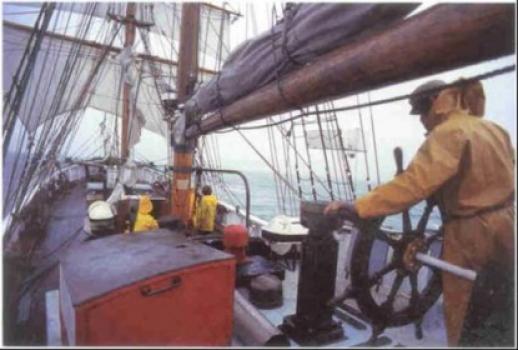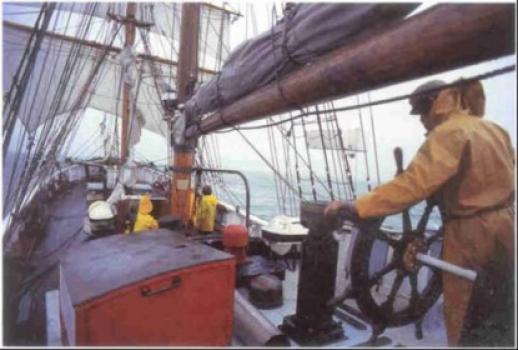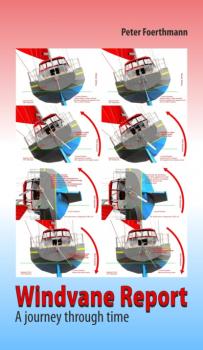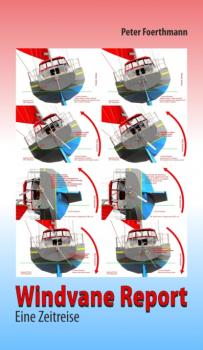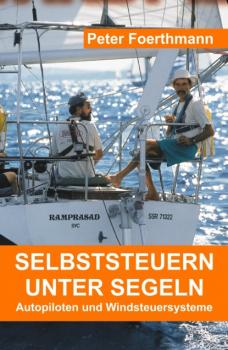Peter Foerthmann
Список книг автора Peter FoerthmannSOUS LA VOILE
Si vous envisagez d'équiper votre voilier d'un pilote automatique – électronique ou mécanique – sans savoir quel système vous conviendrait, voici le livre qu'il vous faut. Peter Foerthmann, expert chevronné, vous explique la différence entre le pilote automatique de cockpit – à monter sur la barre franche ou à roue – et le système intégré, il présente les 12 options différentes pour le pilote automatique mécanique, et il clarifie lesquels conviennent aux différents types de voilier et aux différentes circonstances en mer. Lesquels des systèmes conviennent aux voiliers de compétition et lesquels aux voiliers de tourisme ? Quelles sont les limitations imposées par les conditions en mer et par la consommation d'électricité ? Qu'est-ce que la stabilisation anti-roulis ? Pourquoi le pilote automatique mécanique ne convient-il pas aux voiliers à très faible déplacement (ULDB) ? Comment piloter un catamaran sans problèmes d'alimentation électrique ? Pourquoi un brassage correct est-il si important pour le pilotage automatique ? Quels équipements de pilotage automatique prévoir lors de la construction d'un voilier ? Est-il raisonnable aujourd'hui de construire soi-même un pilote automatique mécanique ?
Ce livre très complet propose des réponses à toutes ces questions et bien d'autres encore. Il s'achève par un aperçu comparatif des possibilités disponibles et par une liste des constructeurs et fournisseurs couvrant pratiquement tous les pilotes automatiques du monde.
Peter Foerthmann est un expert sans égal dans le domaine des pilotes automatiques pour la voile. Né en 1947, il a grandi à Hambourg, au bord de la mer, et a appris la voile dès qu'il a su marcher. Ingénieur, homme de la pratique, Peter Foerthmann a contribué une impulsion créative inégalée au développement du pilotage mécanique. Si celui-ci est toujours indispensable, même à l'ère des bits et bytes, c'est en grande partie grâce à lui.
SELF-STEERING UNDER SAIL
Windvane or autopilot
– it is one of the eternal questions of long-distance sailing. This practical guide brings clarity to the debate: it investigates the technologies behind all of today's common self-steering systems, explains which solutions are best suited to which type of boat with respect to size and construction, describes how to make the most of the various options on offer and examines the relative advantages and disadvantages of each. Which systems are good for racing and which for cruising? What are the limitations of each in terms of sea conditions and power consumption?
Why is proper sail trim so important for good self-steering? Peter Förthmann answers these questions and more without resort to complicated diagrams and impenetrable technical speak. A comprehensive resource written from a wealth of personal experience, this book is full of clearly explained tips to help you choose the right self-steering solution and bring the best out of it in use. An overview of the market and a directory of almost all the self-steering systems available right around the world complete the picture.
Windvane Report
Peter Foerthmann has been the first port of call for bluewater sailors seeking advice in steering matters for decades. His unrivalled expertise – the product of a lifetime developing and manufacturing windvane self-steering systems and contemplating their every complexity – continues to draw enquiries from all over the world. Now available in six languages, his specialist books present the state of the art and provide reassurance – should any be needed – that the fundamental rules of physics still apply in a world increasingly dominated by bits and bytes. This book recounts both the author's personal history of almost half a century in the windvane self-steering segment of the international marine industry and the story of how a business that once built everything by hand has managed to transform itself into what must surely be one of the smallest high-tech engineering companies in existence. The Windvane Report shares the milestones of the author's progress over the decades and recounts some of the remarkable disputes that have erupted in the sector as well as discussing and comparing important technical developments in the field. A roller-coaster ride through the highs and lows of a life on and by the water, this book offers the reader a wide-ranging insight into how Windpilot and the man behind it came to be what they are today.
Windvane Report
In der Welt der Blauwassersegler wird Peter Foerthmann seit Jahrzehnten zurate gezogen, wenn es um Steuerfragen geht. Als Entwickler, Produzent sowie weltweiter Ansprechpartner in der komplexen Materie von Windsteuersystemen ist seine Expertise international gefragt. Seine Fachbücher sind in sechs Sprachen verfügbar und markieren heute den Stand der Technik – die einfachen Gesetzmäßigkeiten der Physik sind auch in Zeiten von Bits und Bytes immer noch gültig. Der Autor schildert in diesem Buch seine ganz persönliche Zeitreise im Verlauf von nun bald einem halben Jahrhundert. Aus seinem anfänglichen Manufakturbetrieb ist heute ein industriell produzierendes Industrieunternehmen geworden – das vermutlich kleinste in Deutschland! Dieses Buch markiert die Lebensstationen des Autors durch die Jahrzehnte, adressiert und vergleicht technische Entwicklungen und schildert Marktauseinandersetzungen im internationalen Wettbewerbsumfeld. Der Leser wird auf eine spannenden Reise durch Höhen und Tiefen mitgenommen und erfährt von den Schlüsselerlebnissen, die dem Buch seinen Titel zu gaben.
Bootsbau - Gestern und Heute
In der Welt der Blauwassersegler wird Peter Foerthmann seit Jahrzehnten zurate gezogen, wenn es um Steuerfragen geht. Als Entwickler, Produzent sowie weltweiter Ansprechpartner in der komplexen Materie von Windsteuersystemen ist seine Expertise international gefragt. Bei einigen Dutzend eigenen, zudem Tausenden von schwimmenden Schwänen, die er beruflich ausgerüstet hat, ist in einem halben Jahrhundert geballtes Fachwissen zusammengekommen. Der besondere Fokus auf wichtige Merkmale von für weltweite Fahrten geeigneten Schiffen allerdings machte es verlockend, die Boote von gestern mit den heutigen zu vergleichen. Dieses Buch benennt die Achillesfersen heutiger Konstruktionen und konstatiert, wie Schiffe auszusehen haben die, wenngleich von gestern, auch morgen noch von heute sind, jedenfalls wenn man willig und bereit ist, beim Segeln zwischen Spaß und Ernst zu unterscheiden, anstatt nur auf das Glück zu vertrauen, dem man die Entscheidung über die unversehrte Ankunft nach langer Reise überlässt.
Boatbuilding - Yesterday and Today
Peter Foerthmann has been the first port of call for bluewater sailors seeking advice in steering matters for decades. His unrivalled expertise – the product of a lifetime developing and manufacturing windvane self-steering systems and contemplating their every complexity – continues to draw enquiries from all over the world. Half a century of experience with both his own boats (several dozen have come and gone over the years) and other people's (Peter has installed self-steering gear for literally thousands of sailors) has left him with a treasure trove of invaluable information to share. This book focuses on the attributes that make a yacht suitable for bluewater passagemaking. It examines the differences between traditional and more recent design conventions and their implications for offshore use, explains why some modern boats may not be such a good idea for long-distance cruising and gives sailors in search of a timeless home from home plenty of practical advice about the features to look out for (and the features to avoid) if they want serious fun on the oceans with as little as possible left to chance.
Selbststeuern unter Segeln
Sie wollen Ihr Schiff mit Autopilot oder Windsteueranlage ausrüsten, sind aber unsicher in Ihrer Entscheidung? Dann ist dies das richtige Buch für Sie. Peter Foerthmann, Konstrukteur und Hersteller der Windpilot-Windsteueranlagen, beschäftigt sich seit 28 Jahren mit dem Thema. Als Segler und Praktiker hat er in seinem Buch eine Materialsammlung zusammengetragen, die derart umfänglich und praxisbezogen bislang wohl nicht veröffentlicht wurde. – Welche Systeme sind für die Küstensegelei geeignet, welche mehr fürs Regattasegeln? – Wo liegen die Grenzen der Einsetzbarkeit in Bezug auf Seegangverhältnisse und Stromverbrauch? – Was bedeutet Gierdämpfung? – Warum sind Windsteuersysteme für ULDB-Jachten ungeeignet? – Wie kann ein Katamaran gesteuert werden ohne Stromverbrauchsprobleme? – Warum ist guter Segeltrimm so wichtig für jede Art von Selbststeuerung? – Was muß bedacht werden bei Schiffskauf oder Bau? – Macht es Sinn, ein Windsteuersystem selbst zu bauen? Diese und viele andere Fragen werden in diesem Buch erschöpfend beantwortet. Ohne auf komplizierte Grafiken oder unverständliches Fachchinesisch zurückzugreifen, präsentiert der Autor umfassende und fundierte Informationen sowie zahlreiche leicht verständliche Tipps für die Selbststeuer-Praxis.
Mythos Weltumsegelung
In der Welt der Blauwassersegler wird Peter Foerthmann seit Jahrzehnten zurate gezogen, wenn es um Steuerfragen geht. Als Entwickler, Produzent sowie weltweiter Ansprechpartner in der komplexen Materie von Windsteuersystemen ist seine Expertise international gefragt. Sein Praxiswissen ist eine Schatztruhe von Erkenntnissen, die hier geöffnet wird. Dieses kleine Buch beschäftigt sich mit den mannigfaltigen Herausforderungen, die auf Schiff und Crew lauern, wenn die Leinen losgeworfen sind, benennt geografische, geopolitische Faktoren und rührt am sozialen Zusammenhalt einer Crew und der Frage, ob sie bis zur Ankunft als eingeschweißtes Team auf See den Herausforderungen standhalten oder nicht, denn Segeln ist wie kein zweiter Sport geeignet, Wahrheiten und Seelenlagen zutage zu fördern.
